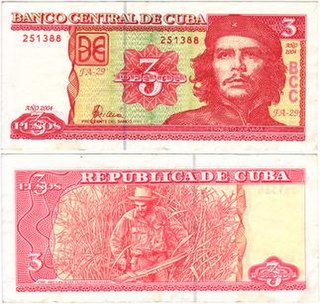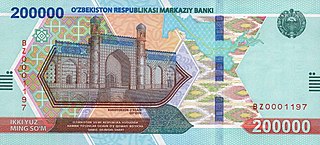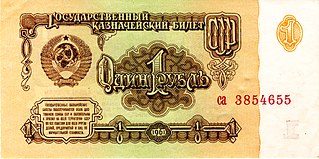
Valentin Sergeyevich Pavlov was a Soviet official who became a Russian banker following the dissolution of the Soviet Union. Born in the city of Moscow, then part of the Russian Soviet Federative Socialist Republic, Pavlov began his political career in the Ministry of Finance in 1959. Later, during the Brezhnev Era, he became head of the Financial Department of the State Planning Committee. Pavlov was appointed to the post of Chairman of the State Committee on Prices during the Gorbachev Era, and later became Minister of Finance in Nikolai Ryzhkov's second government. He went on to succeed Ryzhkov as head of government in the newly established post of Prime Minister of the Soviet Union.

The ruble or rouble is the currency of the Russian Federation. Banknotes and coins are issued by the Central Bank of Russia, which is Russia's monetary authority independent of all other government bodies.

The tenge is the currency of Kazakhstan. It is divided into 100 tiyn.

The Lithuanian litas (ISO currency code LTL, symbolized as Lt; plural litai or litų was the currency of Lithuania, until 1 January 2015, when it was replaced by the euro. It was divided into 100 centų. The litas was first introduced on 2 October 1922 after World War I, when Lithuania declared independence, and was reintroduced on 25 June 1993 following a period of currency exchange from the Soviet ruble to the litas with the temporary talonas then in place. The name was modeled after the name of the country. From 1994 to 2002, the litas was pegged to the U.S. dollar at the rate of 4 to 1. The litas was pegged to the euro at the rate of 3.4528 to 1 since 2002. The euro was expected to replace the litas by 1 January 2007, but persistent high inflation and the economic crisis delayed the switch.

The Armenian dram is the currency of Armenia. It was historically subdivided into 100 luma. The Central Bank of Armenia is responsible for issuance and circulation of dram banknotes and coins, as well as implementing the monetary policy of Armenia.

The hryvnia has been the national currency of Ukraine since 2 September 1996. The hryvnia is divided into 100 kopiyok. It is named after a measure of weight used in Kievan Rus'.

The Cuban peso also known as moneda nacional, is the official currency of Cuba.
The Latvian ruble was the name of two currencies of Latvia: the Latvian ruble, in use from 1919 to 1922, and the second Latvian ruble, in use from 1992 to 1993.

The sum is the official currency of Uzbekistan. Uzbekistan replaced the ruble with the sum at par in on 16 July 1994. No subdivisions of this sum were initially issued and only banknotes were produced, in denominations of 1, 3, 5, 10, 25, 50, 100, 200, 500, 1,000, 5,000, and 10,000 sum. Further series, however, have introduced coins and a subunit, the tiyin. Because it was meant to be a transitional currency, the design was rather simplistic.

The ruble or rouble was the currency of the Soviet Union. It was introduced in 1922 and replaced the Imperial Russian ruble. One ruble was divided into 100 kopecks. Soviet banknotes and coins were produced by the Federal State Unitary Enterprise in Moscow and Leningrad.

The Central Bank of Armenia is the central bank of Armenia with its headquarters in Yerevan. The CBA is an independent institution responsible for issuing all banknotes and coins in the country, overseeing and regulating the banking sector and keeping the government's currency reserves. The CBA is also the sole owner of the Armenian Mint.
Chervonets is the traditional Russian name for large foreign and domestic gold coins. The name comes from the Russian term червонное золото, meaning 'red gold' – the old name of a high-grade gold type.

The banknotes of Zimbabwe were physical forms of Zimbabwe's first four incarnations of the dollar, from 1980 to 2009. The banknotes of the first dollar replaced those of the Rhodesian dollar at par in 1981, one year after the proclamation of independence. The Reserve Bank of Zimbabwe issued most of the banknotes and other types of currency notes in its history, including the bearer cheques and special agro-cheques that circulated between 15 September 2003 and 31 December 2008: the Standard Chartered Bank also issued their own emergency cheques from 2003 to 2004.
Russia's monetary reform of 1993 took place from 26 July to 7 August 1993.
Russia launched a monetary reform on January 1, 1998. Preparation started in August 1997. Replacement of the old banknotes occurred gradually, until 2002.

The monetary reform in the Soviet Union of 1947 was carried out during December 16–19, 1947. It was the second Soviet monetary reform. At the same time the post-World War II rationing system was discontinued. The reform was a combination of redenomination and confiscation, the latter depending on the amount exchanged and whether the monies were kept at the State Labor Savings Banks System of the USSR or not. Amounts under 3,000 Rbls in private bank accounts were not revalued while cash had to be exchanged 10:1 for new roubles. State bonds were exchanged as well, under more favourable to government (politburo) rules of denomination. The confiscative character was attributed to large amounts of counterfeit money produced by Nazi Germany, as well as to the desire to devalue the savings of the profiteers and enrich the government.

On 8 November 2016, the Government of India announced the demonetisation of all ₹500 and ₹1,000 banknotes of the Mahatma Gandhi Series. It also announced the issuance of new ₹500 and ₹2,000 banknotes in exchange for the demonetised banknotes. Prime Minister Narendra Modi said that this decision would curtail the shadow economy, increase cashless transactions and reduce the use of illicit and counterfeit cash to fund illegal activity and terrorism.
The High Denomination Bank Notes (Demonetisation) Act, 1978 was an act of the Indian Parliament that demonetized the high-denomination banknotes of ₹1000, ₹5000, and ₹10000. It was first introduced as the High Denomination Bank Notes (Demonetisation) Ordinance, 1978, by the then President of India Neelam Sanjiva Reddy. The then Prime Minister of India, Morarji Desai of Janata Party, and Finance Minister Hirubhai M. Patel were considered key architects of the policy, while RBI Governor I. G. Patel was opposed to it.
Money in the form of coins was first used in the territory of Azerbaijan in the time of Cyrus the Great first then Alexander the Great as well as before, and continued under the Roman Empire and the Umayyad and Abbasid Caliphates.

The 1996 Ukrainian monetary reform was carried out from 2 to 16 September 1996, and oversaw the replacement of the Ukrainian karbovanets with the new Ukrainian hryvnia in accordance with the Constitution of Ukraine, adopted the same year. Karbovantsiv were exchanged for hryvnias at a rate of 100,000 to 1, with exchanges continuing freely until 1998. The monetary reform helped to launch the political career of Viktor Yushchenko, who oversaw the monetary reform in his capacity as head of the National Bank of Ukraine.













